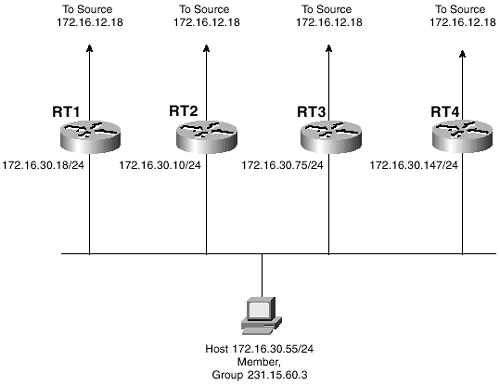| 1: | What is the output of Example 6-63 telling you? Example 6-63 The Output for Troubleshooting Exercise 1 R1# Turban# debug ip mpacket IP multicast packets debugging is on R1# IP: s=192.168.14.35 (Serial0/1.307) d=228.13.20.216 len 573, mrouting disabled IP: s=192.168.14.35 (Serial0/1.307) d=228.13.20.216 len 573, mrouting disabled IP: s=192.168.14.35 (Serial0/1.307) d=228.13.20.216 len 573, mrouting disabled IP: s=192.168.14.35 (Serial0/1.307) d=228.13.20.216 len 573, mrouting disabled IP: s=192.168.14.35 (Serial0/1.307) d=228.13.20.216 len 573, mrouting disabled IP: s=192.168.14.35 (Serial0/1.307) d=228.13.20.216 len 573, mrouting disabled IP: s=192.168.14.35 (Serial0/1.307) d=228.13.20.216 len 573, mrouting disabled IP: s=192.168.14.35 (Serial0/1.307) d=228.13.20.216 len 573, mrouting disabled IP: s=192.168.14.35 (Serial0/1.307) d=228.13.20.216 len 573, mrouting disabled IP: s=192.168.14.35 (Serial0/1.307) d=228.13.20.216 len 573, mrouting disabled IP: s=192.168.14.35 (Serial0/1.307) d=228.13.20.216 len 573, mrouting disabled IP: s=192.168.14.35 (Serial0/1.307) d=228.13.20.216 len 573, mrouting disabled IP: s=192.168.14.35 (Serial0/1.307) d=228.13.20.216 len 573, mrouting disabled |
| A: | Multicast packets are being dropped because multicast routing is not enabled on the router. |
| 2: | What is the output of Example 6-64 telling you? Example 6-64 The Output for Troubleshooting Exercise 2 R2# IP: s=192.168.13.5 (Ethernet0) d=227.134.14.26 len 583, not RPF interface IP: s=192.168.13.5 (Ethernet0) d=227.134.14.26 len 583, not RPF interface IP: s=192.168.13.5 (Ethernet0) d=227.134.14.26 len 583, not RPF interface IP: s=192.168.13.5 (Ethernet0) d=227.134.14.26 len 583, not RPF interface IP: s=192.168.13.5 (Ethernet0) d=227.134.14.26 len 583, not RPF interface IP: s=192.168.13.5 (Ethernet0) d=227.134.14.26 len 583, not RPF interface IP: s=192.168.13.5 (Ethernet0) d=227.134.14.26 len 583, not RPF interface IP: s=192.168.13.5 (Ethernet0) d=227.134.14.26 len 583, not RPF interface IP: s=192.168.13.5 (Ethernet0) d=227.134.14.26 len 583, not RPF interface |
| A: | Packets for group 227.134.14.26, sourced by 192.168.13.5, are being received on interface E0. This interface is apparently not the upstream interface toward the source, however. Therefore, it is not the RPF interface, and the packets are failing the RPF check and are being dropped. |
| 3: | What is the output of Example 6-65 telling you? Example 6-65 The Output for Troubleshooting Exercise 3 R3# debug ip mpacket IP multicast packets debugging is on R3# IP: s=172.16.3.50 (Serial0.405) d=224.0.1.40 (Serial0.407) len 52, mforward IP: s=172.16.3.50 (Ethernet0) d=224.0.1.40 len 62, not RPF interface IP: s=172.16.3.50 (Ethernet0) d=224.0.1.39 len 62, not RPF interface IP: s=172.16.3.50 (Serial0.405) d=224.0.1.39 (Serial0.407) len 52, mforward |
| A: | A router at address 172.16.3.50 is both a C-RP (224.0.1.39) and a mapping agent (224.0.1.40). The Auto-RP messages are being received on interface S0.405 and are being forwarded out interface S0.407. The messages also are being received on interface E0 and are failing the RPF check. Therefore, interface S0.405 is the upstream interface to 172.16.3.50. |
| 4: | In Figure 6-12, which of the four routers is the PIM-designated router? Figure 6-12. The Topology for Troubleshooting Exercises 4, 5, and 6  |
| A: | The PIM DR is the router with the highest IP address. Therefore, RT4 is the PIM DR. |
| 5: | In Figure 6-12, which router is sending IGMPv2 queries to the group member? |
| A: | The IGMPv2 querier is the router with the lowest IP address. Therefore, RT2 is the querier. |
| 6: | Table 6-5 shows the unicast routes to source 172.16.12.18 in Figure 6-12. Which router is the PIM forwarder? Table 6-5. Unicast Routes to 172.16.12.18 in Figure 6-12 | Router | Next Hop | Protocol | Metric | | R1 | 172.16.50.5 | OSPF | 35 | | R2 | 172.16.51.80 | EIGRP | 307200 | | R3 | 172.16.13.200 | EIGRP | 2297856 | | R4 | 172.16.44.1 | OSPF | 83 | |
| A: | The PIM forwarder is the router with the lowest administrative distance. Given equal administrative distances, the forwarder is the router with the lowest metric. The administrative distance of EIGRP is 90, and the distance of OSPF is 110, so EIGRP is lower. Between the two EIGRP routes, R2's route has a lower metric, so R2 is the PIM forwarder. |
| 7: | Example 6-66 shows an RPF trace taken from the PIM domain in Figure 6-10, which is running RIP-2 as its unicast IGP. Does this trace indicate a possible problem? Example 6-66 The mtrace for Troubleshooting Exercise 7 Sombrero# mtrace 192.168.14.35 192.168.10.8 235.1.2.3 Type escape sequence to abort. Mtrace from 192.168.14.35 to 192.168.10.8 via group 235.1.2.3 From source (?) to destination (?) Querying full reverse path... 0 192.168.10.8 -1 192.168.10.1 PIM [192.168.14.0/24] -2 192.168.200.2 PIM [192.168.14.0/24] -3 192.168.201.2 PIM [192.168.14.0/24] -4 192.168.204.1 PIM [192.168.14.0/24] -5 192.168.14.35 Sombrero# |
| A: | Yes. There are equal-cost paths between Beret and Boater via either Turban or Fez. Beret can have only one RPF neighbor, so it picks the neighbor with the highest IP address. In this case, Turban has the highest IP address, but the trace shows that the path through Fez is used. Therefore, there is an apparent problem between Beret and Turban. |